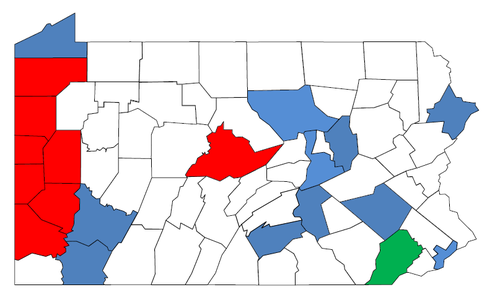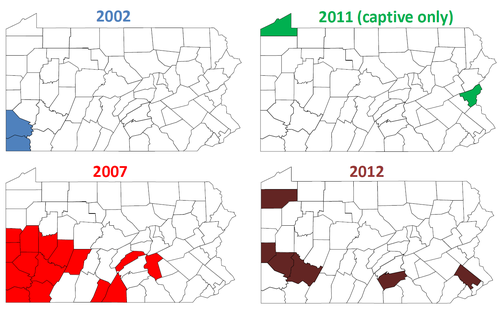Eight years ago, I co-authored a chapter with Steve Shea in the book Biology and Management of White-tailed Deer. It was an overview of deer management in eastern North America. Anticipating future challenges, we described how predictions for climate change might interact with diseases that affect white-tailed deer.
One of those diseases is hemorrhagic disease (HD), which is endemic to the southern United States. There are two distinct viruses that cause HD, epizootic hemorrhagic disease virus (EHDV) and bluetongue virus (BTV). Found in the family of orbiviruses, both EHD and BT viruses can be further divided into different subtypes (i.e. strains), such as EHDV-1, EHDV-6, or BTV 2. Based on existing data, both BTV and EHDV strains cause indistinguishable symptoms in deer and none infect humans.
Outbreaks of HD do occur in the South. But because viral activity occurs annually or every other year down there, any mortality is low. Deer there are more resistant due to a combination of factors all of which are not known but do include acquired and innate immunity.
But it will be different in Pennsylvania. At least until the disease becomes firmly established.
Hemorrhagic disease is transmitted by a small biting midge of the genus Culicoides. This midge needs warm summer temperatures along with exposed muddy areas often found along streams and ponds.
That’s where climate change comes in.
Pennsylvania is experiencing warmer summer temperatures. In addition, in summer we are more likely to experience short-term droughts followed by downpours. Given what we know about the ecology of the midge, droughts followed by downpours are likely create a midge playground exposing muddy areas needed by the insect. There are still many unanswered questions about the circumstances that contribute to midge utopia which makes understanding how climate change and future outbreaks even more challenging.
So why will Pennsylvania deer experience a greater impact due to HD than their cousins to the south? There are several factors that play into this. A big one is herd immunity. Few Pennsylvania deer have been exposed to the disease. Think of an elementary school teacher. They have been exposed to every rhinovirus out there and they have built up the antibodies to fight them off. Ms. Shields might develop a slight sniffle while a parent that came in for career day is laid out on the couch for 3 days. HD is a virus. Few deer in Pennsylvania will have antibodies to the disease so a greater proportion of the population is at risk of getting sick and dying.
But immunity isn’t the only factor. Other potential contributing players are changes in captive cervid populations, new and emergent viruses, changes in domestic cattle, and of course the vector itself, Mr. Midge. We are seeing global changes in orbivirus ecology. Another finger pointing to our changing climate.
Summer 2017 was a northern outbreak year. It extended from Tennessee to Ohio to Pennsylvania. In Pennsylvania, 9 counties had deer positively diagnosed as being infected with HD. Eleven other counties had animals with the symptoms consistent with HD, but the samples came back negative (counties in blue in figure below).

Two different strains of the HD virus were detected in 2017 which was a first for Pennsylvania. The strain EHDV-2 (counties in red) was detected in 2002, 2007, 2011, and 2012, but in 2017 EHDV-6 was confirmed in Chester County.
So what can be done about hemorrhagic disease? Nothing. Live with it.
Mortality events can leave a lasting stench in the air but are very localized and white-tailed deer populations rebound quickly with no lasting impacts.
When I was writing the chapter making predictions about future diseases, Steve and I wrote “Severe outbreaks are more likely to occur in more northern regions (e.g., Virginia and Pennsylvania) because a smaller proportion of the population has developed antibodies to the disease.” It looks like our predictions will be coming true.
Although we don’t get HD every year, outbreaks are covering more counties.

Even if society does something to tackle the root cause of climate change, we can expect that HD will be coming sooner than later to a deer herd near you in Pennsylvania.
-Duane Diefenbach
[I would like to acknowledge Justin Brown, PGC veterinarian, for his efforts in monitoring the disease and providing the figures.]
If you would like to receive email alerts of new blog posts, subscribe here.
And Follow us on Twitter @WTDresearch
